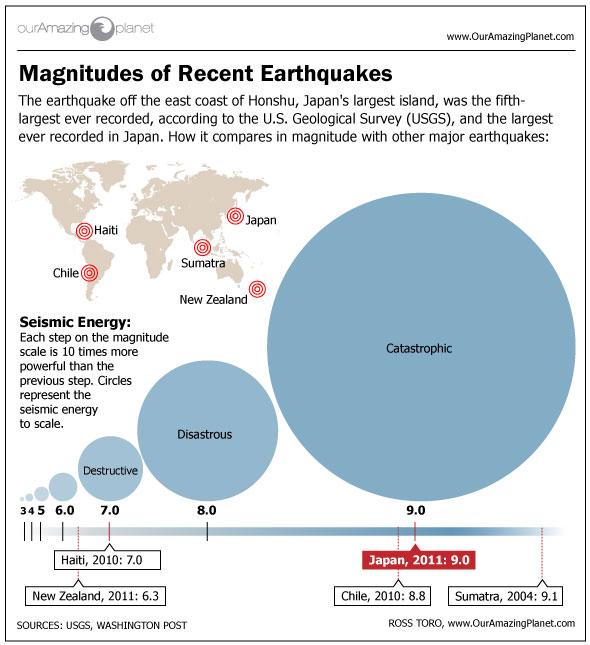
Japan Earthquake Triggered Smaller Quakes Around World

The earthquake that launched a series of disasters in Japan in March triggered micro-quakes and tremors around the world, scientists find.
The catastrophic magnitude 9.0 earthquake that struck off the coast of the Tohoku region of Japan March 11 set off tremors mostly in places of past seismic activity, including southwest Japan, Taiwan, the Aleutians and mainland Alaska, Vancouver Island in Canada, Washington state, Oregon, central California and the central United States. It was unlikely that any of these events exceeded magnitude 3.
Researchers noted, however, that temblors also were detected in Cuba. "Seismologists had never seen tremor in Cuba, so this is an exciting new observation," Justin Rubinstein, a seismologist with the U.S. Geological Survey at Menlo Park, Calif., told OurAmazingPlanet.
Part of the excitement of the find is the insight it could add into the inner workings of earthquakes.
"Studying long-range triggering may help us to better understand the underlying physics of how earthquakes start," explained seismologist Zhigang Peng at the Georgia Institute of Technology in Atlanta.
Quakes where normally quiet
Most of these micro-earthquakes and tremors occurred in places that already had high background levels of seismic activity, including California's Geysers Geothermal Field and the San Andreas Fault. Some of the quakes occurred in low-activity areas, such as central Nebraska, central Arkansas and near Beijing.
Sign up for the Live Science daily newsletter now
Get the world’s most fascinating discoveries delivered straight to your inbox.
"Seismologists generally think of the central U.S. as relatively quiet seismically — there are earthquakes in these areas, but relative to the West Coast of the United States, earthquakes in the central U.S. are infrequent and mostly small," Rubinstein said.
After the Tohoku quake, "in the central U.S., we observed earthquakes in Texas, Louisiana, Arkansas, Kansas, Nebraska, Iowa, South Dakota and Minnesota. For many of these locations, it was the first time we've seen triggered seismicity," Rubinstein said. "I expect that we were able to see all of this triggered seismicity because there is a much denser configuration of seismometers in these states than there has been previously.
"The instrumentation is a part of the USARRAY, a project where seismologists are densely deploying seismometers in a rolling fashion across the United States. These observations are useful because they may suggest where future small earthquakes may occur."
Larger quakes?
A number of large earthquakes in Japan, magnitude 6.0 or greater, occurred well beyond the rupture zone of the Tohoku quake and may have been triggered by the March 11 event, researchers added. These findings agree with recent research suggesting that a major quake can increase the risk of more temblors near it but not of massive quakes farther away.
"It is still too early to rule out the possibility that large distant earthquakes are completely unrelated," Peng told OurAmazingPlanet. "It is quite possible that there is a delayed response in moderate to large earthquakes, or perhaps such distant triggering effects only occur for very large earthquakes."
"A notable example is that after the 2004 magnitude 9.2 Sumatra earthquake, there is a clear increase of seismic activity in Myanmar and Yunnan, China," Peng added. "Several of them are in the magnitude range of 5 to 6, and their distances are mostly beyond 1,000 kilometers [620 miles] to the northern end of the rupture of the Sumatra earthquake. Hence, more analysis is needed to understand how massive earthquakes like the 2004 Sumatra and the 2011 Tohoku earthquakes may affect global seismicity."
The researchers hope to continue this work by looking at other large earthquakes that may have triggered small events, "in particular in the central U.S.," Rubinstein said. "I also foresee people continuing study of tremor in Cuba as well."
And small events aren't all they're looking for.
"We would also like to see whether this event may have caused any clear increase of moderate-size earthquakes that are outside the traditional aftershock zones," Peng said. "In addition, more large earthquakes are needed, somewhat unfortunately, to build up the statistics of distant triggering of moderate to large earthquakes."
The scientists will detail their findings April 15 at the Seismological Society of America meeting in Memphis.
This story was provided by Our Amazing Planet, a sister site to LiveScience.











